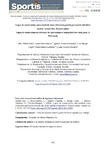Lapso de coactivación paravertebral como referencia para la prevención del dolor lumbar inespecífico. Estudio piloto

Use this link to cite
http://hdl.handle.net/2183/38989
Except where otherwise noted, this item's license is described as Atribución-NoComercial-CompartirIgual 3.0 España
Collections
Metadata
Show full item recordTitle
Lapso de coactivación paravertebral como referencia para la prevención del dolor lumbar inespecífico. Estudio pilotoAlternative Title(s)
Lapse of coactivation as reference for prevention of nonspecific low back pain. A Pilot studyAuthor(s)
Date
2024-09-01Citation
Martín-Ruiz, J.; Ruiz-Sanchis, L.; Tamarit Grancha, I.; Baraja Vegas, L.; BlancoGiménez, P.; Vicente-Mampel, J. (2024). Lapso de coactivación paravertebral como referencia para la prevención del dolor lumbar inespecífico. Estudio piloto. Sportis Sci J, 10 (3), 562-585 https://doi.org/10.17979/sportis.2024.10.3.11008
Abstract
[Resumen]
El dolor lumbar inespecífico, que afecta al 70% de la población, está vinculado a
conductas sedentarias y presenta una desconexión entre anomalías estructurales y la
experiencia dolorosa. Actualmente el ejercicio es considerado la primera línea de
tratamiento, mejorando la biomecánica y la autogestión del dolor. El objetivo principal
de este estudio piloto fue medir antes, y tras un programa de ejercicios, la activación de
la musculatura central encargada de la estabilización global y local del tronco,
empleando electromiografía de superficie en una hiperflexión de tronco. Se realizó un
diseño de estudio prospectivo, cuasi-experimental, incluyendo un grupo de intervención
con dos momentos de evaluación (pre-intervención y tras 4 semanas post-intervención).
Se observó un descenso significativo del lapso de activación en todos los músculos
estudiados tras la finalización del programa: CL derecho e izquierdo con carga (p= .015
y p= .0003 respectivamente) y MT derecho e izquierdo sin carga (p= .028 y p= .036
respectivamente), y una alta correlación de este valor con el descenso del dolor lumbar
(rho= .07). El descenso del lapso de coactivación, como indicador de mayor y mejor
respuesta muscular ante perturbaciones, podría ser una alternativa en la prevención del
dolor lumbar inespecífico. [Abstract]
Nonspecific low back pain, affecting 70% of the population, is linked to sedentary
behaviors and presents a disconnect between structural abnormalities and the pain
experience. Currently, exercise is considered the first line of treatment, improving
biomechanics and pain self-management. The primary objective of this pilot study was
to measure, before and after an exercise program, the activation of the core muscles
responsible for global and local trunk stabilization, using surface electromyography
during trunk hyperflexion. A prospective, quasi-experimental study design was
implemented, including an intervention group with two evaluation points (preintervention and 4 weeks post-intervention). A significant reduction in activation time
was observed in all muscles studied after completing the program: right and left CL
under load (p = .015 and p = .0003, respectively) and right and left MT without load (p
= .028 and p = .036, respectively), with a strong correlation between this value and the
reduction in low back pain (rho = .07). The reduction in coactivation time, as an
indicator of improved and more efficient muscle response to disturbances, could be an
alternative in the prevention of nonspecific low back pain.
Keywords
Dolor lumbar
Lapso de activación
Electromiografía
Estabilidad raquídea
Spinal stability
Low back pain
Electromyography
Activation lapse
Lapso de activación
Electromiografía
Estabilidad raquídea
Spinal stability
Low back pain
Electromyography
Activation lapse
Editor version
Rights
Atribución-NoComercial-CompartirIgual 3.0 España
ISSN
2386-8333






